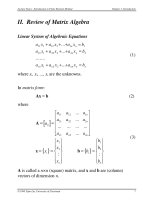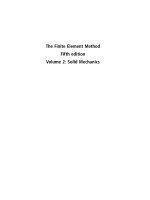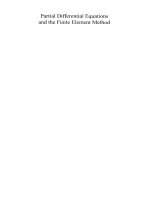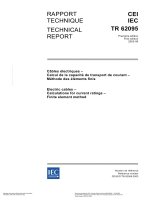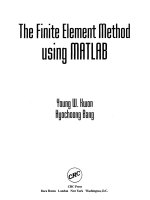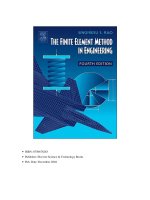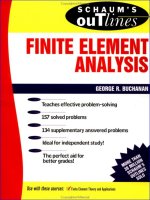finite element method (5th edition) vol2
Bạn đang xem bản rút gọn của tài liệu. Xem và tải ngay bản đầy đủ của tài liệu tại đây (15.29 MB, 373 trang )
The
Finite Element
Method
Fifth edition
Volume
2:
Solid
Mechanics
O.C.
Zienkiewicz,
CBE,
FRS,
FREng
UNESCO Professor of Numerical Methods
in
Engineering
international Centre for Numerical Methods
in
Engineering, Barcelona
Emeritus Professor of Civil Engineering and Director of the institute for
Numerical Methods
in
Engineering, University of Wales, Swansea
R.L.
Taylor
Professor in the Graduate School
Department of Civil and Environmental Engineering
University of California at Berkeley
Berkeley, California
I
EINEMANN
OXFORD AUCKLAND BOSTON JOHANNESBURG MELBOURNE NEW DELHI
Butterworth-Heinemann
Linacre House, Jordan Hill, Oxford
OX2
8DP
225 Wildwood Avenue, Woburn, MA 01801-2041
A division
of
Reed Educational and Professional Publishing Ltd
-@4
member
of
the Reed Elsevier
plc
group
First published in 1967 by McGraw-Hill
Fifth edition published by Butterworth-Heinemann
2000
0
O.C.
Zienkiewicz and R.L. Taylor 2000
All
rights reserved.
No
part
of
this publication
may be reproduced in any material form (including
photocopying
or
storing in any medium by electronic
means and whether
or
not transiently
or
incidentally
to some other use
of
this publication) without the
written permission
of
the copyright holder except
in accordance with the provisions
of
the Copyright,
Designs and Patents Act
1988
or
under the terms
of
a
licence issued by the Copyright Licensing Agency Ltd,
90 Tottenham Court Road, London, England WIP
9HE.
Applications
for
the copyright holder’s written permission
to reproduce any part
of
this publication should
be addressed to the publishers
British Library Cataloguing in Publication Data
A catalogue record for this book is available from the British Library
Library
of
Congress Cataloguing in Publication Data
A catalogue record for this book is available from the Library
of
Congress
ISBN
0 7506 5055
9
Published with the cooperation
of
CIMNE,
the International Centre
for
Numerical Methods in Engineering,
Barcelona, Spain (www.cimne.upc.es)
Typeset by Academic
&
Technical Typesetting, Bristol
Printed and bound by MPG
Books
Ltd
FOR EVERY
TnLE
THAT
WE
rmLisn.
BL~WORTH.HELYEMAW
WU
PAY
FOR
BTCV TO
PLANl
AND
CARE
FOR
A
TREE.
Dedication
This book is dedicated to our wives Helen and Mary
Lou
and our families for their support and patience
during the preparation of this book, and also to all of
our students and colleagues who over the years have
contributed to our knowledge
of
the finite element
method. In particular we would like to mention
Professor Eugenio Oiiate and his group at CIMNE for
their help, encouragement and support during the
preparation process.
Professor
O.C.
Zienkiewicz, CBE, FRS, FREng is Professor Emeritus and Director
of the Institute for Numerical Methods in Engineering at the University
of
Wales,
Swansea, UK. He holds the UNESCO Chair of Numerical Methods in Engineering
at the Technical University of Catalunya, Barcelona, Spain. He was the head of the
Civil Engineering Department at the University of Wales Swansea between 1961
and 1989. He established that department as one of the primary centres of finite
element research. In 1968 he became the Founder Editor of the
International Journal
for Numerical
Methods
in Engineering
which still remains today the major journal
in this field. The recipient of 24 honorary degrees and many medals, Professor
Zienkiewicz is also
a
member of five academies
-
an honour he has received for his
many contributions to the fundamental developments of the finite element method.
In 1978, he became a Fellow of the Royal Society and the Royal Academy of
Engineering. This was followed by his election as a foreign member to the U.S.
Academy of Engineering (1981), the Polish Academy
of
Science (1985), the Chinese
Academy of Sciences (1998), and the National Academy of Science, Italy (Academia
dei Lincei) (1999). He published the first edition of this book in 1967 and it remained
the only book on the subject until 1971.
Professor
R.L.
Taylor has more than
35
years’ experience in the modelling and simu-
lation of structures and solid continua including two years in industry. In 1991 he was
elected to membership in the U.S. National Academy of Engineering in recognition of
his educational and research contributions to the field of computational mechanics.
He was appointed as the
T.Y.
and Margaret Lin Professor of Engineering in 1992
and, in 1994, received the Berkeley Citation, the highest honour awarded by the
University
of
California, Berkeley. In 1997, Professor Taylor was made a Fellow in
the U.S. Association for Computational Mechanics and recently he was elected
Fellow in the International Association of Computational Mechanics, and was
awarded the USACM John von Neumann Medal. Professor Taylor has written sev-
eral computer programs for finite element analysis of structural and non-structural
systems, one of which, FEAP, is used world-wide in education and research environ-
ments. FEAP is now incorporated more fully into the book to address non-linear and
finite deformation problems.
Front covcr image:
A
Finite Element Model
of
the world land speed record (765.035mph) car
THRUST
SSC.
The analysis was done using the finite element method by
K.
Morgan,
0.
Hassan and N.P. Weatherill
at the Institute
for
Numerical Methods in Engineering, University
of
Walcs Swansea,
UK.
(see
K.
Morgan,
0.
Hassan and N.P. Weatherill, ‘Why didn’t the supersonic car fly?’,
Mat/ic~ma/ic~
Tocluy,
Bulletin
of
the
Institirte
of
Matliematics
uncl
Irs
Appliccrtioiu.
Vol.
35. No.
4.
110-1
14,
Aug.
1999).
Preface
to
Volume
2
The first volume of this edition covered basic aspects of finite element approximation
in the context of linear problems. Typical examples of two- and three-dimensional
elasticity, heat conduction and electromagnetic problems in a steady state and tran-
sient state were dealt with and a finite element computer program structure was intro-
duced. However, many aspects of formulation had to be relegated to the second and
third volumes in which we hope the reader will find the answer to more advanced
problems, most of which are of continuing practical and research interest.
In this volume we consider more advanced problems in solid mechanics while in
Volume
3
we consider applications in fluid dynamics. It is our intent that Volume
2
can be used by investigators familiar with the finite element method in general
terms and will introduce them here to the subject of specialized topics in solid
mechanics. This volume can thus in many ways stand alone. Many of the general
finite element procedures available in Volume
1
may not be familiar to a reader intro-
duced to the finite element method through different texts. We therefore recommend
that the present volume be used in conjunction with Volume
1
to which we make
frequent reference.
Two main subject areas in solid mechanics are covered here:
1.
Non-linear problems
(Chapters
1-3
and
10-12)
In these the special problems of
solving non-linear equation systems are addressed. In the first part we restrict
our attention to non-linear behaviour of materials while retaining the assumptions
on small strain used in Volume
1
to study the linear elasticity problem. This serves
as a bridge to more advanced studies later in which geometric effects from large
displacements and deformations are presented. Indeed, non-linear applications
are today of great importance and practical interest in most areas of engineering
and physics. By starting our study first using a small strain approach we believe
the reader can more easily comprehend the various aspects which need to be
understood to master the subject matter. We cover in some detail problems in
viscoelasticity, plasticity, and viscoplasticity which should serve as a basis for
applications to other material models. In our study of finite deformation problems
we present a series of approaches which may be used to solve problems including
extensions for treatment of constraints (e.g. near incompressibility and rigid body
motions) as well as those for buckling and large rotations.
xiv
Preface
to
Volume
2
2.
Plates
and shells
(Chapters
4-9)
This section is
of
course of most interest to those
engaged in ‘structural mechanics’ and deals with a specific class
of
problems in
which one dimension
of
the structure is small compared to the other two. This
application is one
of
the first to which finite elements were directed and which
still is a subject of continuing research. Those with interests in other areas of
solid mechanics may well omit this part on first reading, though by analogy the
methods exposed have quite wide applications outside structural mechanics.
Volume
2
concludes with a chapter on Computer Procedures, in which we describe
application
of
the basic program presented in Volume
1
to solve non-linear problems.
Clearly the variety of problems presented in the text does not permit a detailed treatment
of
all subjects discussed, but the ‘skeletal’ format presented and additional information
available from the publisher’s web site’ will allow readers to make their own extensions.
We would like at this stage to thank once again our collaborators and friends for
many helpful comments and suggestions. In this volume our particular gratitude goes
to Professor Eric Kasper who made numerous constructive comments as well
as
contributing the section on the mixed-enhanced method in Chapter
10.
We would
also like to take this opportunity to thank our friends at CIMNE for providing a
stimulating environment in which much of Volume
2
was conceived.
OCZ and RLT
’
Complete source code for
all
programs
in
the three volumes may be obtained
at
no
cost from the
publisher’s
web
page:
Contents
Preface
to
Volunie
2
1.
General problems in solid mechanics and non-linearity
1.1
Introduction
1.2
1.3 Non-linear quasi-harmonic field problems
1.4
1.5 Concluding remarks
Small deformation non-linear solid mechanics problems
Some typical examples of transient non-linear calculations
References
2.
Solution of non-linear algebraic equations
2.1 Introduction
2.2 Iterative techniques
References
3. Inelastic and non-linear materials
3.1
3.2
3.3
3.4
3.5
3.6
3.7
3.8
3.9
3.10
3.11
3.12
3.13
Introduction
Viscoelasticity
-
history dependence of deformation
Classical time-independent plasticity theory
Computation of stress increments
Isotropic plasticity models
Generalized plasticity
-
non-associative case
Some examples of plastic computation
Basic formulation of creep problems
Viscoplasticity
-
a
generalization
Some special problems of brittle materials
Non-uniqueness and localization in elasto-plastic deformations
Adaptive refinement and localization (slip-line) capture
Non-linear quasi-harmonic field problems
References
4.
Plate bending approximation: thin (Kirchhoff) plates and
C,
continuity
requirements
Xlll
1
1
3
12
14
20
20
22
22
23
36
38
38
39
48
56
61
68
71
75
78
84
88
93
101
104
111
viii
Contents
4.1
4.2
4.3
4.4
4.5
4.6
4.7
4.8
4.9
4.10
4.11
4.12
4.13
4.14
4.15
4.16
4.17
4.18
4.19
4.20
4.21
Introduction
The plate problem: thick and thin formulations
Rectangular element with corner nodes (12 degrees of freedom)
Quadrilateral and parallelogram elements
Triangular element with corner nodes (9 degrees of freedom)
Triangular element of the simplest form
(6
degrees of freedom)
The patch test
-
an analytical requirement
Numerical examples
General remarks
Singular shape functions for the simple triangular element
An 18 degree-of-freedom triangular element with conforming
shape functions
Compatible quadrilateral elements
Quasi-conforming elements
Hermitian rectangle shape function
The 21 and 18 degree-of-freedom triangle
Mixed formulations
-
general remarks
Hybrid plate elements
Discrete Kirchhoff constraints
Rotation-free elements
Inelastic material behaviour
Concluding remarks
-
which elements?
References
5.
‘Thick’ Reissner-Mindlin plates
-
irreducible and mixed formulations
5.1 Introduction
5.2
5.3
5.4
5.5
5.6
5.7
5.8
5.9
5.10 Forms without rotation parameters
5.1
1
Inelastic material behaviour
5.12
The irreducible formulation
-
reduced integration
Mixed formulation for thick plates
The patch test for plate bending elements
Elements with discrete collocation constraints
Elements with rotational bubble or enhanced modes
Linked interpolation
-
an improvement of accuracy
Discrete ‘exact’ thin plate limit
Performance of various ‘thick‘ plate elements
-
limitations of
thin plate theory
Concluding remarks
-
adaptive refinement
References
6.
Shells as an assembly of flat elements
6.1 Introduction
6.2
6.3
6.4 Local direction cosines
6.5
6.6
Stiffness of a plane element in local coordinates
Transformation to global coordinates and assembly of elements
‘Drilling’ rotational stiffness
-
6 degree-of-freedom assembly
Elements with mid-side slope connections only
111
113
124
128
128
133
134
138
145
145
148
149
150
151
153
155
157
158
162
164
166
167
173
173
176
180
183
187
196
199
202
203
208
210
21 1
212
216
216
218
219
22 1
225
230
Contents
ix
6.7 Choice of element
6.8 Practical examples
References
230
23
1
240
7. Axisymmetric shells 244
7.1
Introduction 244
7.2 Straight element 245
7.3 Curved elements 25
1
7.4 Independent slope-displacement interpolation with penalty
functions (thick or thin shell formulations)
26
1
References 264
8.
Shells as a special case of three-dimensional analysis
-
Reissner-Mindlin
assumptions
8.1 Introduction
8.2
8.3
8.4
8.5 Convergence
8.6 Inelastic behaviour
8.7 Some shell examples
8.8 Concluding remarks
Shell element with displacement and rotation parameters
Special case of axisymmetric, curved, thick shells
Special case of thick plates
References
9.
Semi-analytical finite element processes
-
use of orthogonal functions
and ‘finite strip’ methods
9.1 Introduction
9.2 Prismatic bar
9.3 Thin membrane box structures
9.4
9.5
9.6
9.7
9.8 Concluding remarks
Plates and boxes with flexure
Axisymmetric solids with non-symmetrical load
Axisymmetric shells with non-symmetrical load
Finite strip method
-
incomplete decoupling
References
10. Geometrically non-linear problems
-
finite deformation
10.1 Introduction
10.2 Governing equations
10.3
10.4
10.5
10.6
10.7
10.8 Contact problems
10.9
Numerical examples
Variational description for finite deformation
A three-field mixed finite deformation formulation
A mixed-enhanced finite deformation formulation
Forces dependent on deformation
-
pressure loads
Material constitution for finite deformation
266
266
266
275
277
278
279
280
285
286
289
289
292
295
296
297
303
305
308
309
3
12
3 12
314
319
328
332
336
338
347
355
x
Contents
10.10 Concluding remarks
References
359
360
1
1.
Non-linear structural problems
-
large displacement and instability
1
1.1
Introduction
1
1.2
11.3
1
1.4
1
1.5
11.6
11.7 Shells
11.8 Concluding remarks
Large displacement theory
of
beams
Elastic stability
-
energy interpretation
Large displacement theory of thick plates
Large displacement theory of thin plates
Solution of large deflection problems
References
12. Pseudo-rigid and rigid-flexible bodies
12.1 Introduction
12.2 Pseudo-rigid motions
12.3 Rigid motions
12.4
12.5 Multibody coupling by joints
12.6 Numerical examples
Connecting a rigid body to a flexible body
References
13. Computer procedures for finite element analysis
13.1 Introduction
13.2
13.3 Solution of non-linear problems
13.4 Restart option
13.5 Solution of example problems
13.6 Concluding remarks
Description of additional program features
References
Appendix A: Invariants
of
second-order tensors
A.
1
Principal invariants
A.2 Moment invariants
A.3 Derivatives of invariants
Author index
Subject index
365
365
365
373
315
38
1
383
386
39
1
392
396
396
396
398
402
404
409
410
413
413
414
41 5
428
429
430
430
432
432
433
434
437
445
Volume
1:
The
basis
1. Some preliminaries: the standard discrete system
2.
A direct approach to problems in elasticity
3. Generalization of the finite element concepts. Galerkin-weighted residual and
4. Plane stress and plane strain
5.
Axisymmetric stress analysis
6.
Three-dimensional stress analysis
7. Steady-state field problems
-
heat conduction, electric and magnetic potential,
8.
‘Standard’ and ‘hierarchical’ element shape functions: some general families of
9.
Mapped elements and numerical integration
-
‘infinite’ and ‘singularity’ elements
variational approaches
fluid flow, etc
C,
continuity
10. The patch test, reduced integration, and non-conforming elements
1
1.
Mixed formulation and constraints
-
complete field methods
12. Incompressible problems, mixed methods and other procedures of solution
13. Mixed formulation and constraints
-
incomplete (hybrid) field methods, bound-
14. Errors, recovery processes and error estimates
15.
Adaptive finite element refinement
16.
Point-based approximations; element-free Galerkin
-
and other meshless methods
17. The time dimension
-
semi-discretization of field and dynamic problems and
18.
The time dimension
-
discrete approximation in time
19. Coupled systems
20.
Computer procedures for finite element analysis
Appendix A. Matrix algebra
Appendix
B.
Tensor-indicia1 notation in the approximation
of
elasticity problems
Appendix
C.
Basic equations of displacement analysis
Appendix
D.
Some integration formulae for a triangle
Appendix E. Some integration formulae for a tetrahedron
Appendix
F.
Some vector algebra
Appendix G. Integration by parts
Appendix
H.
Solutions exact at nodes
Appendix
I.
Matrix diagonalization or lumping
ary/Trefftz methods
analytical solution procedures
Volume
3:
Fluid dynamics
1.
Introduction and the equations of fluid dynamics
2.
Convection dominated problems
-
finite element approximations
3.
A general algorithm for compressible and incompressible flows
-
the characteristic
4.
Incompressible laminar flow
-
newtonian and non-newtonian fluids
5.
Free surfaces, buoyancy and turbulent incompressible flows
6.
Compressible high speed gas flow
7.
Shallow-water problems
8.
Waves
9.
Computer implementation of the CBS algorithm
Appendix A. Non-conservative form of Navier-Stokes equations
Appendix B. Discontinuous Galerkin methods in the solution of the convection-
Appendix C. Edge-based finite element formulation
Appendix
D.
Multi grid methods
Appendix
E.
Boundary layer
-
inviscid flow coupling
based split (CBS) algorithm
diffusion equation
General problems in solid
mechanics and non-linearity
1
.I
Introduction
In the first volume we discussed quite generally linear problems of elasticity and of
field equations. In many practical applications the limitation of linear elasticity or
more generally of linear behaviour precludes obtaining an accurate assessment of
the solution because of the presence of non-linear effects and/or because of the
geometry having a ‘thin’ dimension in one or more directions. In this volume we
describe extensions to the formulations previously introduced which permit solutions
to both classes of problems.
Non-linear behaviour
of
solids takes two forms: material non-linearity and geo-
metric non-linearity. The simplest form
of
a non-linear material behaviour is that
of elasticity for which the stress is not linearly proportional to the strain. More gen-
eral situations are those in which the loading and unloading response of the material
is different. Typical here is the case of classical elasto-plastic behaviour.
When the deformation of a solid reaches a state for which the undeformed and
deformed shapes are substantially different a state of
$finite deformation
occurs. In
this case
it
is no longer possible to write linear strain-displacement or equilibrium
equations on the undeformed geometry. Even before finite deformation exists it is
possible to observe
buckling
or
load bifurcations
in some solids and non-linear equilib-
rium effects need
to
be considered. The classical Euler column where the equilibrium
equation for buckling includes the effect of axial loading is an example of this class of
problem.
Structures in which one dimension is very small compared with the other two
define plate and shell problems.
A
plate
is a flat structure with one thin direction
which is called the thickness, and a
shell
is a curved structure in space with one
such small thickness direction. Structures with two small dimensions are called
beams, frames,
or
rods.
Generally the accurate solution of linear elastic problems
with one (or more) small dimension(s) cannot be achieved efficiently by using the
three-dimensional finite element formulations described in Chapter
6
of Volume
1
and conventionally in the past separate theories have been introduced.
A
primary
reason is the numerical ill-conditioning which results in the algebraic equations
making their accurate solution difficult to achieve. In this book we depart from
past tradition and build a much stronger link to the full three-dimensional theory.
2
General problems in solid mechanics and non-linearity
This volume will consider each of the above types of problems and formulations
which make practical finite element solutions feasible. We establish in the present chap-
ter the general formulation for both static and transient problems of a non-linear kind.
Here we show how the linear problems of steady state behaviour and transient beha-
viour discussed in Volume
1
become non-linear. Some general discussion of transient
non-linearity will be given here, and in the remainder of this volume we shall primarily
confine our remarks to quasi-static (i.e. no inertia effects) and static problems only.
In Chapter
2
we describe various possible methods for solving non-linear algebraic
equations. This
is
followed in Chapter
3
by consideration of material non-linear
behaviour and the development of a general formulation from which a finite element
computation can proceed.
We then describe the solution of plate problems, considering first the problem of thin
plates (Chapter
4)
in which only bending deformations are included and, second, the
problem in which both bending and shearing deformations are present (Chapter
5).
The problem of shell behaviour adds in-plane membrane deformations and curved
surface modelling. Here we split the problem into three separate parts. The first, com-
bines simple flat elements which include bending and membrane behaviour to form a
faceted approximation to the curved shell surface (Chapter
6).
Next we involve the
addition of shearing deformation and use of curved elements to solve axisymmetric
shell problems (Chapter
7).
We conclude the presentation of shells with a general
form using curved isoparametric element shapes which include the effects of bending,
shearing, and membrane deformations (Chapter
8).
Here a very close link with the full
three-dimensional analysis of Volume
1
will be readily recognized.
In Chapter
9
we address a class of problems in which the solution in one coordinate
direction is expressed as a series, for example a Fourier series. Here, for linear
material behavior, very efficient solutions can be achieved for many problems.
Some extensions to non-linear behaviour are also presented.
In the last part of this volume we address the general problem of finite deformation
as well as specializations which permit large displacements but have small strains. In
Chapter
10
we present a summary for the finite deformation of solids. Basic relations
for defining deformation are presented and used to write variational forms related to
the undeformed configuration of the body and also to the deformed configuration. It
is shown that by relating the formulation to the deformed body a result is obtain
which is nearly identical to that for the small deformation problem we considered
in Volume
1
and which we expand upon in the early chapters of this volume. Essential
differences arise only in the constitutive equations (stress-strain laws) and the
addition of a new stiffness term commonly called the
geometric
or
initial
stress
stiffness. For constitutive modelling we summarize alternative forms for elastic and
inelastic materials. In this chapter contact problems are also discussed.
In Chapter
11
we specialize the geometric behaviour to that which results in large
displacements but small strains. This class of problems permits use of all the consti-
tutive equations discussed for small deformation problems and can address classical
problems of instability. It also permits the construction of non-linear extensions to
plate and shell problems discussed in Chapters
4-8
of this volume.
In Chapter
12
we discuss specialization of the finite deformation problem to
address situations in which a large number of small bodies interact (multiparticle
or granular bodies) or individual parts of the problem are treated as rigid bodies.
Small deformation non-linear solid mechanics problems
3
In the final chapter we discuss extensions to the computer program described in
Chapter 20 of Volume
1
necessary to address the non-linear material, the plate and
shell, and the finite deformation problems presented in this volume. Here the discus-
sion is directed primarily to the manner in which non-linear problems are solved. We
also briefly discuss the manner in which elements are developed to permit analysis of
either quasi-static (no inertia effects) or transient applications.
1.2
Small deformation non-linear solid mechanics
problems
1.2.1
Introduction and notation
In this general section we shall discuss how the various equations which we have
derived for linear problems in Volume
1
can become non-linear under certain circum-
stances. In particular this will occur for structural problems when non-linear stress-
strain relationships are used. But the chapter in essence recalls here the notation and
the methodology which we shall adopt throughout this volume. This repeats matters
which we have already dealt with in some detail. The reader will note how simply the
transition between linear and non-linear problems occurs.
The field equations for solid mechanics are given by equilibrium (balance of
momentum), strain-displacement relations, constitutive equations, boundary condi-
tions, and initial
condition^.^^'
In the treatment given here we will use two notational forms. The first is a Cartesian
tensor indicial form (e.g. see Appendix B, Volume
1)
and the second is a matrix form
as used extensively in Volume
1
.’
In general, we shall find that both are useful to describe
particular parts of formulations. For example, when we describe large strain problems
the development of the so-called ‘geometric’ or ‘initial stress’ stiffness is most easily
described by using an indicial form. However, in much of the remainder, we shall find
that it is convenient to use the matrix form. In order to make steps clear we shall here
review the equations for small strain in both the indicial and the matrix forms. The
requirements for transformations between the two will also be again indicated.
For the small strain applications and fixed Cartesian systems we denote coordinates as
x,
y,
z
or in index form as
xI
,
x2,
x3.
Similarly, the displacements will be denoted as u,
v,
w
or
ul
,
u2,
u3. Where possible the coordinates and displacements will be denoted as
x,
and
u,, respectively, where the range of the index
i
is
I,
2,3
for three-dimensional applications
(or
1,2 for two-dimensional problems). In matrix form we write the coordinates as
and displacements as
4
General problems in solid mechanics and non-linearity
1.2.2
Weak form for equilibrium
-
finite element discretization
The equilibrium equations (balance of linear momentum) are given in index form as
+
b,
=
piii,
i,
j
=
1,2,3 (1.3)
where
aii
are components of (Cauchy) stress,
p
is mass density,
bj
are body force
components and
(')
denotes partial differentiation with respect to time. In the
above, and in the sequel, we always use the convention that repeated indices in a
term are summed over the range of the index. In addition, a partial derivative with
respect to the coordinate
xi
is indicated by a comma, and a superposed dot denotes
partial differentiation with respect to time. Similarly, moment equilibrium (balance
of angular momentum) yields symmetry of stress given indicially as
(1.4)
ff
=
ff
'I
.I'
Equations (1.3) and (1.4) hold at all points
xi
in the domain of the problem
R.
Stress
boundary conditions are given by the traction condition
-
(1
3)
t.
=
ff n.
=
t.
I
J'J
I
for all points which lie on the part of the boundary denoted as
rr.
A
variational (weak) form of the equations may be written by using the procedures
described in Chapter 3 of Volume
1
and yield the virtual work equations given by'.8.9
In the above Cartesian tensor form, virtual strains are related to virtual displacements
as
=
+
"J
1)
(1.7)
In this book we will often use a transformation to matrix form where stresses are
given in the order
=
[ffll
ff22
O33
ff12 ff23
ff31
1'
T
(1.8)
=
[Gx
0).
gz?
OYJ
ff,;
ffz,]
and strains by
where symmetry of the tensors is assumed and 'engineering' shear strains are
introduced as*
Ti,
=
2EiI
(1.10)
to make writing of subsequent matrix relations in a consistent manner.
The transformation to the six independent components of stress and strain is
performed by using the index order given in Table
1.1.
This ordering will apply to
*
This
form
is necessary to allow
the
internal work always
to
be
written as
cTs
Small deformation non-linear solid mechanics problems
5
Table
1.1
Index relation between tensor and matrix forms
Form Index value
Matrix 123456
Tensor(l.2,3)
11
22 33
12
23
31
21
32
13
VY
3)'
.Y:
Tensor
(.Y.J'.z)
.Y.Y
yy
:z
XY?'
J'r
?.Y
many subsequent developments also. The order is chosen to permit reduction to two-
dimensional applications by merely deleting the last two entries and treating the third
entry as appropriate for plane or axisymmetric applications.
In matrix form, the virtual work equation is written as (see Chapter 3 of Volume
1)
Finite element approximations to displacements and virtual displacements are
denoted by
u(x,
t)
=
N(x)u(t) and Su(x)
=
N(x)SU (1.12)
or in isoparametric form as
u(6,
t)
=
N(C)U(t); Su(6)
=
N(C)SU
with x(S)
=
N(6)x (1.13)
and may be used to compute virtual strains as
SE
=
SSU
=
(SN)SU
=
BSU
(1.14)
in which the three-dimensional strain-displacement matrix is given by [see Eq. (6.1
l),
Volume
11
(1.15)
In the above,
U
denotes time-dependent nodal displacement parameters and
6U
represents arbitrary virtual displacement parameters.
Noting that the virtual parameters
6U
are arbitrary we obtain for the discrete
problem*
(1.16)
where
MU
+
P(o)
=
f
M
=
JI!
NTpN dR
(1.17)
f
=
jnNTbdfl
+
.I
NTtdr
(1.18)
rr
*
For simplicity we omit direct damping which leads to the term
Cu
(see Chapter
17,
Volume
I)
6
General problems in solid mechanics and non-linearity
and
P(o)
=
In
BTo
dR
(1.19)
The term
P
is often referred to as the
stress divergence
or
stress force
term.
relations (see Chapter 2, Volume 1) as
In the case of linear elasticity the stress is immediately given by the stress-strain
(T
=
DE
(1.20)
when effects of initial stress and strain are set to zero. In the above the
D
are the usual
elastic moduli written in matrix form. If a displacement method is used the strains are
obtained from the displacement field by using
E
=
BU
(1.21)
Equation (1.19) becomes
P(o)
=
(
BTDB
do)
U
=
Ku
(1.22)
in which
K
is the linear stiffness matrix. In many situations, however, it is necessary to
use non-linear or time-dependent stress-strain (constitutive) relations and in these
cases we shall have to develop solution strategies directly from Eq. (1.19). This will
be considered further in detail in later chapters. However, at this stage we simply
need to note that
(r
=
C(E)
(1.23)
quite generally and that the functional relationship can be very non-linear and
occasionally non-unique. Furthermore, it will be necessary to use a mixed approach
if constraints, such as near incompressibility, are encountered. We address this latter
aspect in Sec. 1.2.4; however, before doing
so
we consider first the manner whereby
solution of the transient equations may be computed by using step-by-step time
integration methods discussed in Chapter 18 of Volume
1.
1.2.3
Non-linear formulation of transient and steady-state
problems
To
obtain a set of
algebraic equations
for transient problems we introduce a discrete
approximation in time. We consider the GN22 method or the Newmark procedure as
being applicable to the second-order equations (see Chapter 18, Volume 1). Dropping
the tilde on discrete variables for simplicity we write the approximation
to
the
solution as
U(fn+l)
=",,+I
and now the equilibrium equation (1.16) at each discrete time
t,,
I
may be written in a
residual form
as
Qn+l
=
f,+l
-
M4l.I
-
P,+l
=
0
(
1.24)
Small deformation non-linear solid mechanics problems
7
(1.25)
Using the GN22 formulae, the discrete displacements, velocities, and accelerations
are linked by [see Eq. (18.62), Volume
11
un+l
=u,+atU,+;(l
-/32)At2iin+92At2iin+,
(1.26)
U,
+
1
=
U,,
+
(1
-
PI)
Alii,
+
PI
Alii,
+
1
(1.27)
where
At
=
tnil
-
t,.
Equations (1.26) and (1.27) are simple, vector, linear relationships as the coefficient
PI
and
P2
are assigned
a
priori
and it is possible to take the basic unknown in Eq.
(1.24) as any one of the three variables at time step
n
+
1
(Le.
u,,+~,
Un+l
or
&+I).
In such schemes we
take the constant
P2
as zero and note that this allows
un+
I
to be evaluated directly
from the initial values at time
t,
without solving any simultaneous equations.
Immediately, therefore, Eq. (1.24) will yield the values of
ii,+
I
by simple inversion
of
matrix
M.
If the
M
matrix is diagonalized by any one of the methods which we have discussed
in Volume 1, the solution for
ii,+
I
is trivial and the problem can be considered solved.
However, such explicit schemes are only conditionally stable as we have shown in
Chapter 18 of Volume
1
and may require many time steps to reach a steady state
solution. Therefore for transient problems and indeed for all static (steady state)
problems, it is often more efficient to deal with implicit methods. Here, most con-
veniently,
u,+
can be taken as the basic variable from which
U,+
and
ii,
+
can be
calculated by using Eqs (1.26) and (1.27). The equation system (1.24) can therefore
be written as
*(u,,+1)
=
*,,+I
=
0
(1.28)
The solution of this set of equations will require an iterative process if the relations
are non-linear. We shall discuss various non-linear calculation processes in some
detail in Chapter 2; however, the Newton-Raphson method forms the basis of
most practical schemes. In this method an iteration is as given below
A
very convenient choice for explicit schemes is that of
ii,+
(
1.29)
where
du:
is an increment to the solution* such that
(1.30)
For problems in which path dependence is involved it is necessary to keep track of the
total increment
during the iteration and write
Uk
,+,
+
1
=
U,
+
Aut''
(1.31)
Thus the total increment can be accumulated by using the same solution increments as
(1.32)
Uk+l
-
k
k
n+
1
-
UP,+
1
+
dun
Au:'
=
u::
f
-
u,,
=
Auk
+
du:
-
Note that an italic
'd'
is used
for
a solution increment and an upright
'd'
for
a differential.
8
General problems in solid mechanics and non-linearity
in which a quantity without the superscript
k
denotes a converged value from a
previous time step. The initial iterate may be taken as zero or, more appropriately,
as the converged solution from the last time step. Accordingly,
u,,+~
1
=
u,,
giving also
Aui
=
0
(1.33)
A solution increment is now computed from
Eq.
(1.29) as
(1.34)
k
-I
k
'uf:
(KT)
*l7+I
where the
tangent
nmtrix
is computed as
K;
=
-~
dun+
I
From expressions (1.24) and (1.26) we note that the above equations can be rewritten
as
We note that the above relation is similar but not identical to that
of
linear elasti-
city. Here
D!
is the tangent modulus matrix for the stress-strain relation (which
may or may not be unique but generally is related to deformations in a non-
linear manner).
Iteration continues until a convergence criterion of the form
(1.35)
or similar is satisfied for some small tolerance
E.
A good practice is to assume the
tolerance at half machine precision. Thus, if the machine can compute to about 16
digits of accuracy, selection of
E
=
lo-'
is appropriate. Additional discussion on
selection of appropriate convergence criteria is presented in Chapter 2.
Various forms of non-linear elasticity have in fact been used in the present context
and here we present a simple approach in which we define a strain energy
W
as a
function of
E
W
=
W(E)
=
W(E,)
and we note that this definition gives us immediately
dW
de
c=-
(1.36)
If the nature of the function
W
is known, we note that the tangent modulus
D:
becomes
The algebraic non-linear solution in every time step can now be obtained by the
process already discussed. In the general procedure during the time step, we have
to take an initial value for
u,~+~,
for example,
u,+~
=
u,
(and similarly for u,+l
and
ii17+])
and then calculate at step
2
the value of at
k
=
1, and obtain
1
Small deformation non-linear
solid
mechanics problems
9
duf,
+
updating the value of
ut+
by
Eq.
(1.30). This of course necessitates calculation
of stresses at
t,+,
to obtain the necessary forces. It is worthwhile noting that the
solution for steady state problems proceeds on identical lines with solution variable
chosen as
u,,+
but now we simply say
u,?+
=
tif7+
=
0
as well as the corresponding
terms in the governing equations.
1.2.4
Mixed or irreducible forms
The previous formulation was cast entirely in terms of the so-called displacement
formulation which indeed was extensively used in the first volume. However, as we
mentioned there, on some occasions it is convenient
to
use mixed finite element
forms and these are especially necessary when constraints such as incompressibility
arise. It has been frequently noted that certain constitutive laws, such as those of
viscoelasticity and associative plasticity that we will discuss in Chapter 3, the material
behaves in a nearly incompressible manner. For such problems a reformulation
following the procedures given in Chapter 12 of Volume
1
is necessary. We remind
the reader that on such occasions we have two choices of formulation. We can
have the variables
u
and
p
(where
p
is the mean stress) as a two-field formulation
(see Sec. 12.3 or 12.7
of
Volume 1) or we can have the variables
u,
p
and
E,
(where
E,
is the volume change) as a three-field formulation (see Sec. 12.4, Volume
I).
An
alternative three-field form is the enhanced strain approach presented in Sec. 11.5.3
of Volume
1.
The matter of which we use depends on the form of the constitutive
equations. For situations where changes in volume affect only the pressure the two-
field form can be easily used. However, for problems in which the response is coupled
between the deviatoric and mean components of stress and strain the three-field
formulations lead to much simpler forms from which to develop a finite element
model. To illustrate this point we present again the mixed formulation of Sec. 12.4
in Volume
1
and show in detail how such coupled effects can be easily included
without any change to the previous discussion on solving non-linear problems. The
development also serves as a basis for the development
of
an extended form which
permits the treatment of finite deformation problems. This extension will be presented
in Sec. 10.4
of
Chapter 10.
A
three-field mixed method for general constitutive models
In order to develop a mixed form for use with constitutive models in which mean and
deviatoric effects can be coupled we recall (Chapter
12
of Volume 1) that mean and
deviatoric matrix operators are given by
(1.37)
where
I
is the identity matrix.
10
General problems in solid mechanics and non-linearity
As in Volume
1
we introduce independent parameters
E,:
and
p
describing volumetric
change and mean stress (pressure), respectively. The strains may now be expressed in
a
mixed
form as
E
=
I,,
(SU)
+
f
mE,
(1.38)
and the stresses in a mixed form as
IS
=
Id6
+
mp
(1.39)
where
6
is the set of stresses deduced directly from the strains, incremental strains, or
strain rates, depending on the particular constitutive model form. For the present we
shall denote this stress by
6
=
IS(&)
(I
.40)
where we note it is not necessary to split the model into mean and deviatoric parts.
The Galerkin (variational) equations for the case including transients are now
given by
p]dfl=O
6p[mT(Su)
-
E,]
dR
=
0
Introducing finite element approximations to the variables as
u
M
u
=
N,U,
p
M
p
=
NPp
and
and similar approximations
to
virtual quantities as
E,
M
E,
=
N,E,
6u
M
Si
=
Nu&,
6p
=
6p
=
Np6p
and
6~,
62,
=
N,6E,
the strain and virtual strain in an element become
E
=
IdBU
+fmN,E,,
6~
=
Id
B
6U
+
f
mN,SE,
(1.41)
(
1.42)
in which
B
is the standard strain-displacement matrix given in Eq. (1.15). Similarly,
the stresses in each element may be computed by using
IS
=
Id8
+
mN,p
(1.43)
where again
6
are stresses computed as in Eq. (1.40) in terms of the strains
E.
into Eq. (1.41) we obtain the set of finite element equations
Substituting the element stress and strain expressions from Eqs (1.42) and (1.43)
P+MU=f
Pp
-
cp
=
0
-CTE,
+
EU
=
0
(
1.44)
Small deformation non-linear
solid
mechanics problems
1
1
where
P=
J
BTcdR,
n
P,
=
+
J
N:mTirdR
n
E=
N,m BdR
Jn
(1.45)
If the pressure and volumetric strain approximations are taken locally in each
element and N,
=
N, it is possible to solve the second and third equation of (1.44)
in each element individually. Noting that the array
C
is now symmetric positive
definite, we may always write these as
p=c-
1
P,
E,
=
C-'Eu
=
Wu
The mixed strain in each element may now be computed as
where
B,
=
N,W
(1.46)
(
1.47)
(
1.48)
defines a
mixed
form
of
the volumetric strain-displacement equations.
forms''.'
'
From the above results it is possible to write the vector
P
in the alternative
€'=I
BTcdR
(1
The computation of
P
may then be represented in a matrix form
as
(1.49)
(1
SO)
in which we note the inclusion of the transpose
of
the matrices appearing in the
expression for the mixed strain given in Eq. (1.47). Based on this result we observe
that
it
is
not necessary to compute the true mixed stress except when reporting
final results where, for situations involving near incompressible behaviour,
it
is crucial
to compute explicitly the mixed pressure to avoid any spurious volumetric stress
effects.
12
General problems in solid mechanics and non-linearity
The last step in the process is the computation of the tangent for the equations. This
is straightforward using forms given by Eq. (1.40) where we obtain
dir
=
DTd&
Use of Eq. (1.47)
to
express the incremental mixed strains then gives
(1.51)
It should be noted that construction of a modified modulus term given by
requires very few operations because of the sparsity and form of the arrays
In
and m.
Consequently, the multiplications by the coefficient matrices B and
B,
in this form is
far more efficient than constructing a full
B
as
B=IdB+fmB, (1.53)
and operating on DT directly.
The above form for the mixed element generalizes the result in Volume
1
and is
valid for use with many different linear and non-linear constitutive models. In
Chapter 3 we consider stress-strain behaviour modelled by viscoelasticity, classical
plasticity, and generalized plasticity formulations. Each of these forms can lead
to
situations in which a nearly incompressible response is required and for many
examples included in this volume we shall use the above mixed formulation. Two
basic forms are considered: four-noded quadrilateral or eight-noded brick isopara-
metric elements with constant interpolation in each element for one-term approxima-
tions to
N,
and
Nl,
by unity; and nine-noded quadrilateral or 27-noded brick
isoparametric elements with linear interpolation for N, and N,
.*
Accordingly, in
two dimensions we use
N,,
=N,
=
[
1
<
771
or
[
1
-Y
1.1
and in three dimensions
N,=N,=[l
77
<]
or [l
.Y
y
z]
The elements created by this process may be used to solve a wide range of problems in
solid mechanics, as we shall illustrate in later chapters of this volume.
1.3
Non-linear quasi-harmonic field problems
In subsequent chapters we shall touch upon non-linear problems in the context
of
inelastic constitutive equations for solids, plates, and shells and in geometric effects
Formulations using the eight-noded quadrilateral and twenty-noded brick serendipity eleinents may
also
be
constructed: however.
we
showed in Chapter
1
I
of
Volume
I
that these elements do not fully satisfy the
mixed patch test.
Non-linear quasi-harmonic field problems
13
arising from finite deformation. In Volume
3
non-linear effects will be considered for
various fluid mechanics situations. However, non-linearity also may occur in many
other problems and in these the techniques described in this chapter are still univer-
sally applicable. An example of such situations is the quasi-harmonic equation which
is encountered in many fields of engineering. Here we consider a simple quasi-harmo-
nic problem given by (e.g. heat conduction)
p~$
+
VTq
-
Q(4)
0
(1.54)
with suitable boundary conditions. Such a form may be used to solve problems
ranging from temperature response in solids, seepage in porous media, magnetic
effects in solids, and potential fluid flow. In the above,
q
is a flux and generally this
can be written as
q
=
q(4,
V4)
=
k(A
V4)V4
or, after linearization,
dq
=
ko
d4
+
k'
d(V4)
where
The source term
Q(4)
also can introduce non-linearity.
the
q
term the problem
A
discretization based on Galerkin procedures gives after integration by parts of
(1.55)
and is still valid if
q
and/or
Q
(and indeed the boundary conditions) are dependent on
4
or its derivatives. Introducing the interpolations
4
=
N& and
64
=
NS$ (1.56)
a discretized form is given as
!l!
=
f(&)
-
c&
-
P,($)
=
0
(1.57)
where
C=
NTpcNdR
.I,
P,=
-
NTqdR
I!
f
=
1
NTQ($) dR
-
J'
NTq,l dT
I!
Tu
(1.58)
Equation
(1.57)
may be solved following similar procedures described in Chapter
18, Volume
1.
For instance, just as we did with GN22 we can now use GN
1
1
as
@,I+
I
=
4%
+
(1
-
Qh
+
Q&+
I
(1.59)
